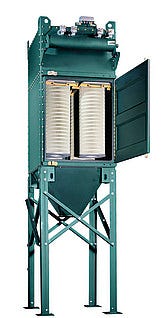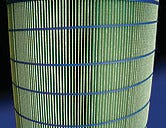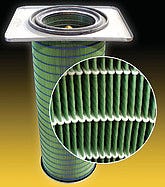August 18, 2010
By Tomm Frungillo and Tony Supine, Camfil Farr Air Pollution Control
When it comes to choosing filters for a cartridge dust collector, powder and bulk processors sometimes regard these items as more or less of a commodity. If Filter A and Filter B both offer the same rated efficiency and fill any special requirements, (i.e., the need for fire retardant media) then the lowest-priced filter would appear to be the better choice. In fact, the opposite may be true. But it requires a “Total Cost of Ownership” (TCO) calculation to know for certain.
Similar in concept to life-cycle costing, TCO is a useful approach for deciding what filters to select for a dust collection application. TCO incorporates a step-by-step evaluation process encompassing three categories:
* Energy – the amount of energy required to operate the dust collector from day to day, including electrical costs, compressed air usage and CO2 emissions.
* Consumables – the items that are replaced periodically throughout the life of the equipment.
* Maintenance and Disposal – the time it takes to service the equipment and the costs of disposing of the consumables.
|
Dust collector with door open and cartridges visible. |
If you are considering the purchase of a complete new dust collection system, you will have control over more of these variables, such as the selection of electrical components that impact energy use. But even if you are simply assessing what replacement filters to use in an existing dust collector, a TCO analysis can yield useful information and surprising results.
Figure 1 is a sample dust collection worksheet used to gather TCO data. Following is a more in-depth look at some of the key items that may be included in such a worksheet and how they impact TCO.
Energy
Many factors influence a dust collector’s electrical energy consumption. Though there can be numerous electrical loads associated with a dust collector – timer boards, rotary airlock motors, etc. – the largest portion of the electrical load relates to the fan or blower required to move air through the system.
It is important to understand that differential pressure losses are directly proportional to the amount of air moved through the system, and the amount of air in turn is directly proportional to the cost of electrical energy consumed by the fan. While ducting should be optimized at the time of installation to reduce the amount of pressure loss, we will focus on the energy control devices and filters which contribute to variable pressure losses during dust collector operation.
How many days will the system operate per year? | 365 days |
How many hours will the system operate per day? | 24 hours |
What is the volume of air required to operate the system? | 10,400 cfm |
How much does a kilowatt-hour cost? | $0.10 per kWh |
What is the cost of no production for one hour? | $500 |
What is the cost of Filter A (conventional-pleat filter)? | $90 |
What is the cost of Filter B (open-pleat filter)? | $120 |
How many filter cartridges are in the dust collector? | 16 |
What is the shipping cost per filter? | $10 |
What is the labor and overhead rate for one hour? | $80 |
How much does it cost to dispose of a filter? | $10 |
How much does a variable frequency drive (VFD) cost? | $2600 |
What is the current interest rate? | 4.5% |
How many minutes does it take to change Filter A? | 10 minutes |
How many minutes does it take to change Filter B? | 5 minutes |
Will there be a VFD operating the system? | Yes |
Figure 1. Dust Collector Filter Total Cost of Ownership - Sample Data Collection Worksheet
When running a dust collector with a constant speed fan (i.e., with no energy control device), the amount of air moving through the collector will vary during the service life of the filters. Why does this occur? When filters are clean and differential pressure is at its lowest, more air blows through the system than required, essentially wasting energy. As filters become loaded with dust, static pressure is increased, and less air is moved as a result. Thus, filters use more energy in the early stages of service life and less in the final stages.
One way to reduce this problem is via a mechanical damper at the blower outlet. Depending on the type of filters used, periodic adjustment of the damper to regulate air flow can save an average of 1-in. w.g. of static pressure over the life of the filter.
|
A different view of Filter B open-pleat media. |
A far more effective approach is the use of a variable frequency drive (VFD) that electrically controls fan speed. When filters are new, speed is decreased to obtain the desired air flow. When filters become loaded, the fan is sped up to maintain a constant air flow. The electrical control is highly efficient in maintaining desired air flow, and energy consumption is greatly decreased. The use of a VFD has been proven to save an average of 4 in. w.g. of static pressure over the life of the filter. The added capital cost of installing a VFD on a dust collector will vary. However, the return on investment is typically under one year.
Additional factors that impact energy use are:
* Premium efficiency vs. standard efficiency fan motors: Industrial electric motors are the largest consumer of electricity in the U.S. Premium efficiency motors that meet or exceed requirements of the Energy Independence and Security Act (EISA) are designed to combat the energy waste that occurs with conventional motors. Used to power a dust collector fan, a premium efficiency motor can pay for itself in reduced electrical power use and/or through rebates and incentive programs offered by many electric utilities. These motors run cooler and last longer, making them ideal for use with VFDs for optimum fan speed control and energy savings.
* Compressed air usage: The amount of compressed air required to perform pulse-cleaning of filters and maintain a lower pressure drop is important to consider. Compressed air requirements will vary significantly depending on filter design.
* CO2 emissions cost: Although this does not contribute tangibly to TCO, the amount of CO2 emissions from operation of a dust collector should be considered and stated as a cost impact on the environment.
Consumables, Maintenance, and Disposal
The items in these two categories are straightforward and can be summarized as follows:
* Cartridge replacement – the amount of money spent on replacement filters alone.
* Transportation cost – the amount of money required to have replacement filters delivered to the operation site.
* Inventory cost – typically, replacement filters are not received the day they are replaced in the system. This component is the amount of money required to carry inventory of replacement filters.
* Labor cost – the cost of labor required for maintenance personnel to change filters.
* Disposal cost - depending upon the type of material being filtered, there is a cost associated with properly disposing of filters laden with process dust.
* Downtime cost – this will vary from facility to facility, but it refers to the amount of time in lost production due to shutting down the collector for a filter change.
Clearly, when viewed on an annualized basis, these factors are largely dependent on the anticipated service life of the filter. The change-out schedule will determine how many filters you can expect to buy, transport, store, and dispose, as well as the costs of labor and downtime associated with filter service.
Energy |
Electrical savings |
Using standard efficiency motor |
Using premium efficiency motor |
Using premium efficiency motor with VFD |
Return on investment for VFD |
Compressed air savings |
CO2 emissions savings to environment |
Total energy savings (with VFD controller): |
Consumables |
Cartridge only replacement savings (50% longer life) |
Transportation savings |
Inventory savings |
Total consumable savings: |
Maintenance and Disposal |
Labor savings |
Disposal savings |
Downtime savings |
Total maintenance and disposal savings: |
TOTAL COST OF OWNERSHIP (TCO) SAVINGS: |
Figure 2. New Dust Collector Example Projected Total Cost of Ownership Savings for 16-Cartridge Dust Collector using Filter B - 8760 operating hours (one year)
TCO Examples
The worksheet in Figure 1 compares two different filters, both containing standard media with standard cartridge filtration efficiency. Filter A, at a unit cost of $90, is a conventional dimple-pleat style cartridge filter. Filter B, at a unit cost of $120, is an open-pleat style cartridge filter designed for extended service life and lower pressure drop operation.
|
A different view of Filter B open-pleat media. |
Figure 2, the Life Cycle Comparison Report, uses data from the worksheet in Figure 1 to project the TCO of a new 16-cartridge dust collection system equipped with Filter B. Though it has a higher initial cost than Filter A, Filter B operates at a lower pressure drop over a longer period of time to save on energy use. The Energy Category in Figure 2 shows savings achieved by combining Filter B with energy-efficient electrical components. The use of a premium efficiency motor alone yields savings over a standard efficiency motor, but the best savings by far are realized with the combination of a VFD and premium efficiency motor – nearly $12,000 in projected savings over 8760 operating hours or one year.
Filter B also offers 50 percent longer service life, which translates into an additional $764.82 savings in consumable costs and $1712.69 savings in maintenance and disposal costs. Added to energy reductions, the total cost of ownership savings per year is $14,416.54.
As noted earlier, TCO analysis can also be helpful with existing dust collectors. This was the case in a real-life application involving the metalizing of aircraft engine parts, in which the manufacturer was experiencing problems with plugging of filter cartridges in three identical dust collectors. “Filter A” – a conventional dimple-pleat filter with fire-retardant media – lasted only about 1000 hours, necessitating frequent replacement.
Dust Coll. 1 (Filter A) | Dust Coll. 2 (Filter B) | Dust Coll. 3 (Filter C) | |
Hours of Operation | 5280 | 5280 | 5280 |
Average pressure drop (inches w.g.) | 4 | 2.7 | 2.5 |
Fan efficiency | 0.8 | 0.8 | 0.8 |
Cost per kWh ($) | 0.15 | 0.15 | 0.15 |
Air Flow (CFM) | 8000 | 8000 | 8000 |
Energy Cost ($) | $3926 | $2565 | $2352 |
Filter Cost | $9731 | $5838 | $5838 |
Labor Costs | $790 | $395 | $395 |
Disposal Costs | $973 | $486 | $486 |
Total Cost of Ownership 5280 Hours | $15,420 | $9284 | $9071 |
Energy savings over 5280 hours | $1361 | $1574 | |
TOTAL SAVINGS OVER 5280 hours | $6136 | $6349 |
Figure 3. Existing Dust Collector TCO Example
Total Cost of Ownership Comparison Dust Collector Replacement Filter A vs. Filter B Actual Savings over 16 months (5280 hours)
|
Filter A - Cutaway view of dimple-pleat media. |
The company decided to test a comparably rated Filter B (i.e., same efficiency but an extended-life, low-pressure-drop open-pleat filter) in two of the three collectors. The filters lasted for 16 months or 5280 operating hours before needing replacement. Figure 3 shows the TCO savings achieved by switching to Filter B. Based on a combination of field experience and analysis of the TCO data, the manufacturer switched all three collectors to Filter B and is now saving over $50,000 per year in maintenance costs.
By now it should be clear that the lowest-priced dust collector filter is not necessarily the most economical or the most sustainable choice. TCO provides a useful tool for comparing the real costs of operating an existing dust collector with different filters, as well as a tool for evaluating the impact of energy-saving electrical components in the design of new and refurbished dust collection systems.
Tomm Frungillo is the director of international sales and director of focus markets for Camfil Farr Air Pollution Control (APC, Jonesboro, AR). Tony Supine has held numerous positions with the company including research and development manager, technical director, and his current role as plant manager. Camfil Farr APC is a leading manufacturer of dust collection equipment and a member of Camfil Farr, the largest air filter manufacturer in the world. The authors can be reached at 800-479-6801, 870-933-8048, or [email protected]
You May Also Like






